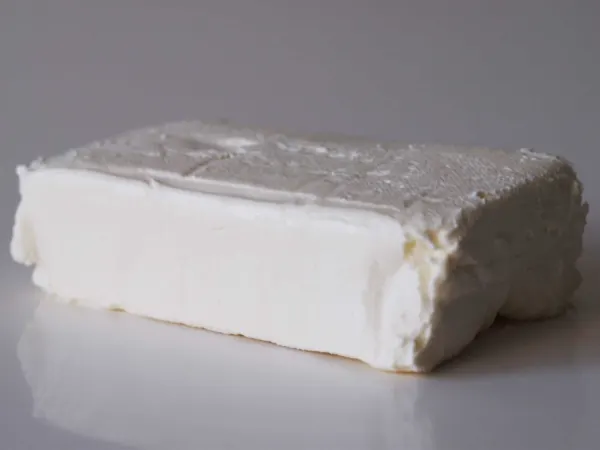Cream Cheese
Dairy
Age Suggestion
6 months
Iron-Rich
No
Common Allergen
Yes

When can babies have cream cheese?
Cream cheese may be introduced as soon as baby is ready to start solids, which is generally around 6 months of age.
Cream cheese got its name from the time-honored practice of skimming rich fat—the cream—from the top of milk, then letting it ripen. Humans have been making cheese this way around the Mediterranean Sea since the 7th century B.C., and when Europeans colonized the Americas, they brought dairy processing traditions like this one with them.
Is cream cheese healthy for babies?
Yes. Cream cheese is rich in fat, which is a concentrated source of energy to fuel baby’s rapid growth and development. Specifically, cream cheese offers lots of saturated fat, which is one of the most abundant types of fat in breast milk. In recent years, saturated fat has been scrutinized for its association with heart disease in adults, but research shows that it has its place as a part of a balanced diet, and that it may have a more neutral impact on the heart than previously thought. Cream cheese is also rich in vitamin A, as well as carotenoids such as beta carotene. These nutrients work together to support brain development, skin health, immunity, and growth and development.
Is cream cheese a common allergen?
Yes. Cream cheese is typically made from cow’s milk, which is a common food allergen in young children, accounting for about one-fifth of all childhood food allergies. Keep in mind that dairy products from other ruminants such as sheep, goat, and buffalo may provoke similar allergic reactions to cow’s milk dairy products. If baby is allergic to dairy, know that it is an allergy that often disappears with time. Research shows that the majority of children with cow's milk allergy will outgrow it by age 6, and many babies with milder symptoms of milk protein allergy (which can show up as painless blood in stool) are able to successfully reintroduce cow's milk as early as their first birthday, with the guidance of their doctors.
Milk is a known cause of food protein-induced enterocolitis syndrome, also known as FPIES. FPIES is a delayed allergy to food protein which causes the sudden onset of repetitive vomiting and diarrhea to begin a few hours after ingestion. Left untreated, the reaction can result in significant dehydration. Thankfully, like other forms of milk allergy, FPIES which presents early in life is generally outgrown by the time the child has reached 3-5 years of age.
For those with older children who are lactose intolerant (keep in mind this is uncommon for infants and toddlers), some good news: compared with milk and certain other dairy products, cream cheese may be better tolerated by those with lactose intolerance. Note that if your child is lactose-intolerant, it’s important to find calcium-rich foods to consume regularly to ensure a balanced diet and support bone health. Search for naturally low-lactose cheeses and dairy products labeled “lactose-free.”
If you suspect baby may be allergic to milk, consult an allergist before introducing dairy products like cheese. Based on baby’s risk factors and history, your allergist may recommend allergy testing, or may instead advise dairy introduction under medical supervision in the office. If the risk is low, you may be advised to go ahead and introduce dairy in the home setting. As with all common allergens, start by serving a small quantity on its own for the first few servings, and if there is no adverse reaction, gradually increase the quantity over future servings.
Is cream cheese a choking hazard for babies?
It can be, if spread thickly or served in globs. To reduce the risk, prepare and serve cream cheese in an age-appropriate way. As always, make sure you create a safe eating environment and stay within an arm’s reach of baby during meals. For more information on choking, visit our sections on gagging and choking and familiarize yourself with the list of common choking hazards.
Videos
Is cream cheese the same as neufchatel cheese?
In North America, cream cheese and neufchatel cheese are almost the same. They are both made of pasteurized cow’s milk with stabilizers to keep the cheese intact. They are creamy and spreadable at room temperature. They taste fresh with a mild tang, and because their texture is comparable, they can be used interchangeably in many recipes. Their main difference is the amount of milk fat. By American law, neufchatel must contain between 20 and 33% fat compared to at least 33% for cream cheese. American-style neufchatel is not the same as Neufchâtel, the soft cheese with a bloomy rind from the Normandy region of France.
How do you serve cream cheese to babies?
Every baby develops on their own timeline, and the suggestions on how to cut or prepare particular foods are generalizations for a broad audience.
6 months old +:
Spread a thin layer of cream cheese on toast for baby to grab and munch on. If you’d like to offer baby bagel or bialy with cream cheese, go right ahead. Baby won’t consume much of the bagel, but gnawing and munching can be great for oral motor skill development. Avoid cream cheese with honey until 12 months of age to minimize the risk of infant botulism.
9 months old +:
As baby’s fine motor control develops, try sticking fruit or vegetables in a bowl of whipped cream cheese for baby to grab and dip. You can also add cream cheese to egg strips or frittata, or stir it into mashed vegetables or grains for baby.
12 months old +:
Explore any style of cream cheese, as desired. Spread cream cheese on other age-appropriate foods, mix it into the batter for baked goods or into shared meals, or offer as a dip.
Get easy, adaptable ideas for meals to share with baby in our guide, 75 Lunches for Babies & Toddlers.
Written by
Expert Tips Delivered to Your Inbox
Sign up for weekly tips, recipes and more!
The content offered on SolidStarts.com is for informational purposes only. Solidstarts is not engaged in rendering professional advice, whether medical or otherwise, to individual users or their children or families. No content on this site, regardless of date, should ever be used as a substitute for direct medical advice from your doctor or your medical or health professional, nutritionist, or expert in pediatric feeding and eating. By accessing the content on SolidStarts.com, you acknowledge and agree that you are accepting the responsibility for your child’s health and well-being. In return for providing you with an array of content “baby-led weaning” information, you waive any claims that you or your child may have as a result of utilizing the content on SolidStarts.com.







